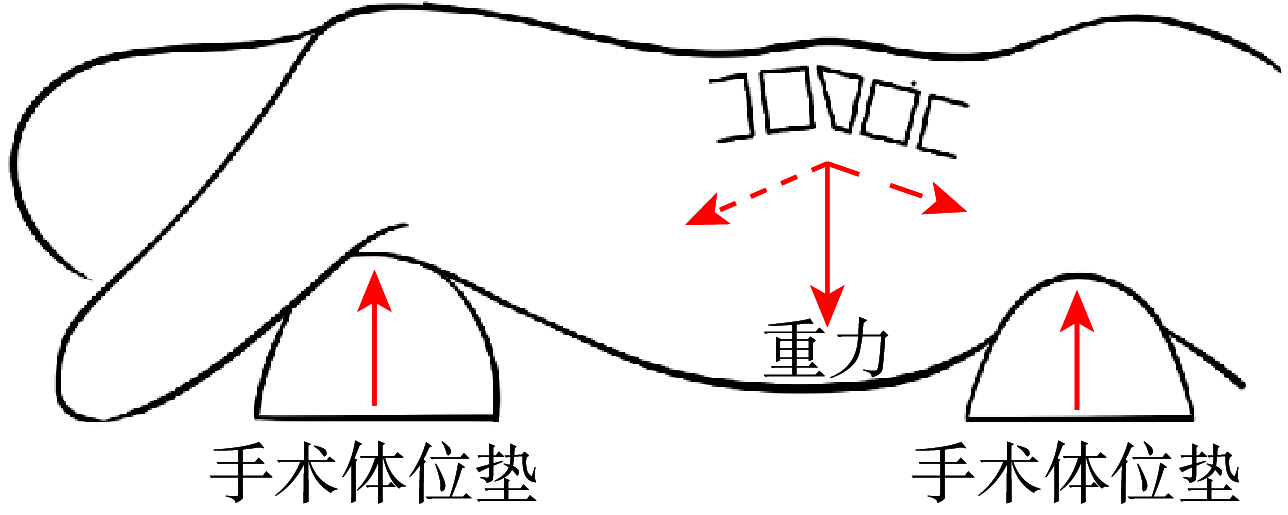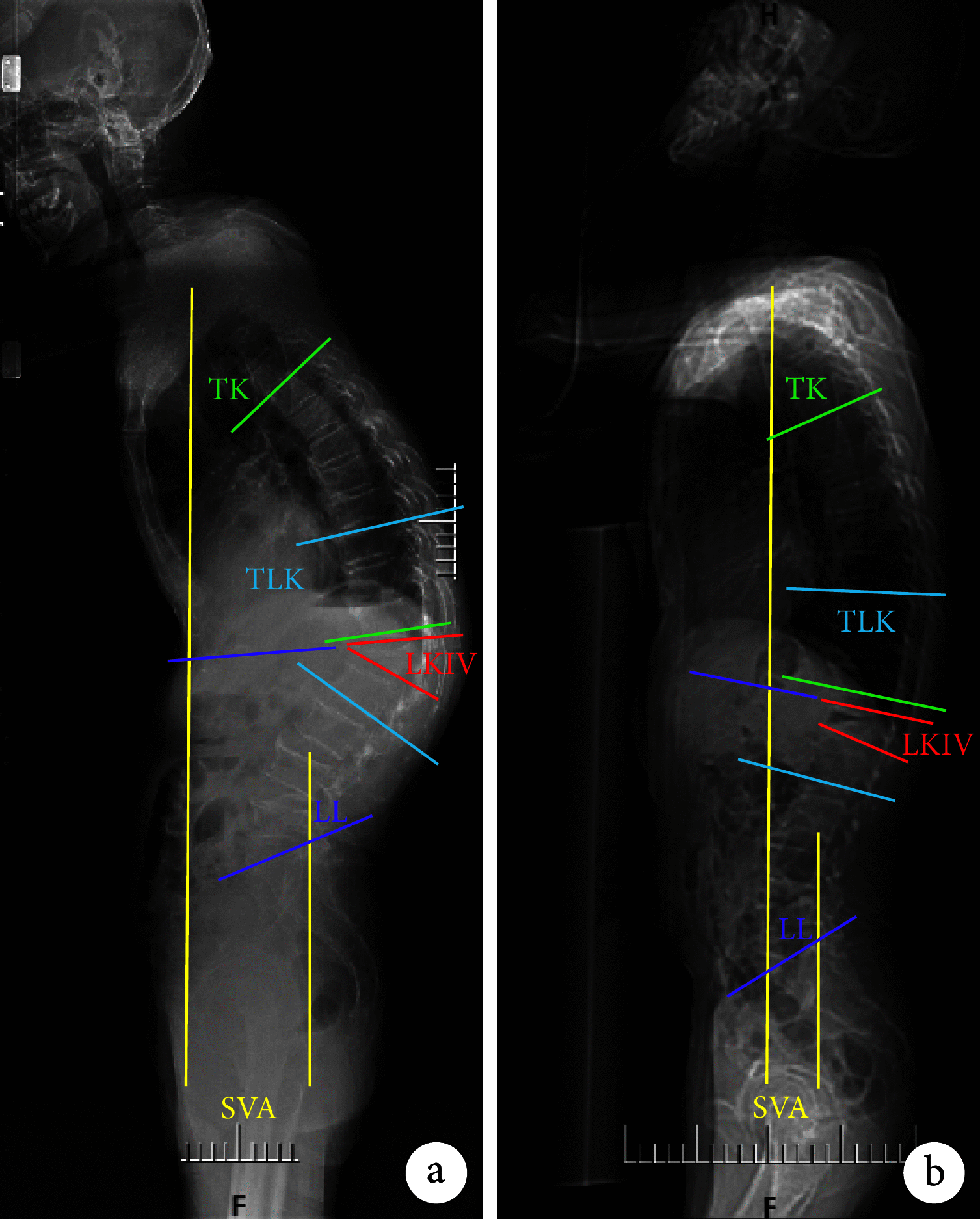[Back-forward bending CT in simulated surgical position to evaluate the remaining real angle and flexibility of thoracolumbar kyphosis secondary to old osteoporotic vertebral compression fracture]
- PMID: 37070314
- PMCID: PMC10110746
- DOI: 10.7507/1002-1892.202211107
[Back-forward bending CT in simulated surgical position to evaluate the remaining real angle and flexibility of thoracolumbar kyphosis secondary to old osteoporotic vertebral compression fracture]
Abstract
Objective: To introduce a scout view scanning technique of back-forward bending CT (BFB-CT) in simulated surgical position for evaluating the remaining real angle and flexibility of thoracolumbar kyphosis secondary to old osteoporotic vertebral compression fracture.
Methods: A total of 28 patients with thoracolumbar kyphosis secondary to old osteoporotic vertebral compression fracture who met the selection criteria between June 2018 and December 2021 were included in the study. There were 6 males and 22 females with an average age of 69.5 years (range, 56-92 years). The injured vertebra were located at T 10-L 2, including 11 cases of single thoracic fracture, 11 cases of single lumbar fracture, and 6 cases of multiple thoracolumbar fractures. The disease duration ranged from 3 weeks to 36 months, with a median of 5 months. All patients received examinations of BFB-CT and standing lateral full-spine X-ray (SLFSX). The thoracic kyphosis (TK), thoracolumbar kyphosis (TLK), local kyphosis of injured vertebra (LKIV), lumbar lordosis (LL), and the sagittal vertical axis (SVA) were measured. Referring to the calculation method of scoliosis flexibility, the kyphosis flexibility of thoracic, thoracolumbar, and injured vertebra were calculated respectively. The sagittal parameters measured by the two methods were compared, and the correlation of the parameters measured by the two methods was analyzed by Pearson correlation.
Results: Except LL ( P>0.05), TK, TLK, LKIV, and SVA measured by BFB-CT were significantly lower than those measured by SLFSX ( P<0.05). The flexibilities of thoracic, thoracolumbar, and injured vertebra were 34.1%±18.8%, 36.2%±13.8%, and 39.3%±18.6%, respectively. Correlation analysis showed that the sagittal parameters measured by the two methods were positively correlated ( P<0.001), and the correlation coefficients of TK, TLK, LKIV, and SVA were 0.900, 0.730, 0.700, and 0.680, respectively.
Conclusion: Thoracolumbar kyphosis secondary to old osteoporotic vertebral compression fracture shows an excellent flexibility and BFB-CT in simulated surgical position can obtain the remaining real angle which need to be corrected surgically.
目的: 介绍一种基于手术实景的全脊柱过伸位CT定位像(back-forward bending CT,BFB-CT)的影像技术,分析其评估陈旧性骨质疏松性胸腰段骨折后凸畸形的真实后凸角度与柔韧度可行性。.
方法: 选择2018年6月—2021年12月符合选择标准的28例陈旧性骨质疏松性胸腰段骨折后凸畸形患者纳入研究。男6例,女22例;年龄56~92岁,平均69.5岁。骨折椎体位于T 10~L 2,其中胸椎单发骨折11例,腰椎单发骨折11例,胸腰段多发骨折6例。病程3周~36个月,中位时间5个月。所有患者均行站立位脊柱全长侧位X线片(standing lateral full-spine X-ray,SLFSX)和BFB-CT检查,采用Cobb角法分别测量胸椎后凸角(thoracic kyphosis,TK)、胸腰段后凸角(thoracolumbar kyphosis,TLK)、伤椎局部后凸角(local kyphosis of injured vertebrae,LKIV)和腰椎前凸角(lumbar lordosis,LL),并测量矢状面垂直轴(sagittal vertical axis,SVA);参考脊柱侧凸柔韧度计算方式,分别计算胸椎、胸腰段及伤椎局部后凸柔韧度。比较两种方式所测各矢状位参数,并采用Pearson相关分析两种方式所测各参数的相关性。.
结果: 两种体位所测矢状位参数除LL比较差异无统计学意义( P>0.05)外,BFB-CT测得的TK、TLK、LKIV、SVA均明显小于SLFSX所测结果,差异有统计学意义( P<0.05)。胸椎、胸腰段及伤椎局部后凸柔韧度分别为34.1%±18.8%、36.2%±13.8%、39.3%±18.6%。相关性分析示,两种方式所测TK、TLK、LKIV、SVA均成正相关( P<0.001),相关系数 r分别为0.900、0.730、0.700、0.680。.
结论: 陈旧性骨质疏松性胸腰段骨折继发的后凸畸形具有良好的柔韧度,基于手术实景的BFB-CT可测得需要通过手术矫正的真实后凸角度。.
Keywords: Old thoracolumbar fracture; kyphosis; kyphotic flexibility; osteoporosis; simulated surgical position.
Conflict of interest statement
利益冲突 在课题研究和文章撰写过程中不存在利益冲突;课题经费支持没有影响文章观点和对研究数据客观结果的统计分析及其报道
Figures



Similar articles
-
Does kyphoplasty affect the global sagittal alignment in patients with osteoporotic vertebral fractures? A systematic review and meta-analysis.Eur Spine J. 2023 Jan;32(1):38-45. doi: 10.1007/s00586-022-07479-2. Epub 2022 Dec 5. Eur Spine J. 2023. PMID: 36469131
-
Does spinal sagittal imbalance lead to future vertebral compression fractures in osteoporosis patients?Spine J. 2021 Aug;21(8):1362-1375. doi: 10.1016/j.spinee.2021.03.014. Epub 2021 Mar 22. Spine J. 2021. PMID: 33766788
-
Percutaneous kyphoplasty for osteoporotic vertebral compression fractures improves spino-pelvic alignment and global sagittal balance maximally in the thoracolumbar region.PLoS One. 2020 Jan 30;15(1):e0228341. doi: 10.1371/journal.pone.0228341. eCollection 2020. PLoS One. 2020. PMID: 31999783 Free PMC article.
-
[Effectiveness of long segment fixation combined with vertebroplasty for severe osteoporotic thoracolumbar compressive fractures].Zhongguo Xiu Fu Chong Jian Wai Ke Za Zhi. 2013 Nov;27(11):1331-7. Zhongguo Xiu Fu Chong Jian Wai Ke Za Zhi. 2013. PMID: 24501892 Chinese.
-
The influence of osteoporotic vertebral fractures on global sagittal alignment in elderly patients: a systematic review and meta-analysis.Eur Spine J. 2023 Jul;32(7):2580-2587. doi: 10.1007/s00586-023-07780-8. Epub 2023 May 24. Eur Spine J. 2023. PMID: 37222801
Cited by
-
Application of standing hyperextension lateral radiograph and full-length spine computed tomography scout view in the prone position in spinal flexibility assessment for patients with symptomatic old osteoporotic thoracolumbar fracture with kyphotic deformity: A comparative analysis.J Orthop. 2025 Mar 17;62:191-196. doi: 10.1016/j.jor.2025.03.043. eCollection 2025 Apr. J Orthop. 2025. PMID: 40241856
References
Publication types
MeSH terms
LinkOut - more resources
Full Text Sources
Medical
Miscellaneous
